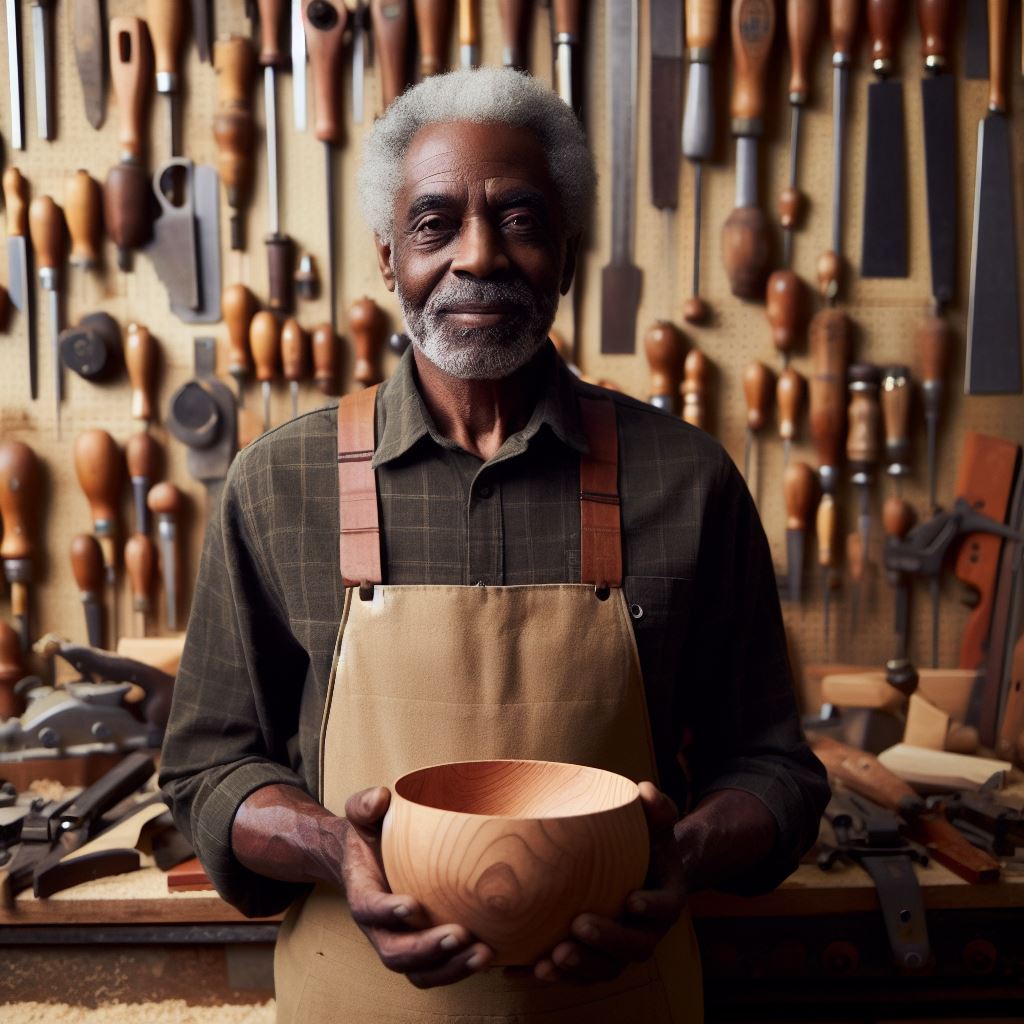Introduction
Famous American carpenters and their work will be explored in this blog chapter.
Did you know that the woodworking industry in America generates over $12 billion annually?
Famous American carpenters have left enduring marks through iconic creations.
Frank Lloyd Wright designed innovative structures like “Fallingwater.” Sam Maloof crafted exquisite wooden furniture.
Wendell Castle revolutionized art furniture. George Nakashima’s elegant pieces showcased organic forms.
These carpenters reshaped American design.
The Beginnings of Carpentry in America
Discussion on the early origins of carpentry as a profession in America
Carpentry, as a profession, has deep roots in America, tracing back to the early settlers.
For the early English, Dutch, and French settlers, carpentry was an essential skill needed to survive in the new land.
These settlers relied on skilled carpenters to construct their homes, churches, and other necessary structures.
Carpenters were highly respected members of the community, known for their craftsmanship and expertise in woodworking.
They would often apprentice young aspiring carpenters, passing down their knowledge and skills from one generation to the next.
The demand for carpenters increased as the population grew and the country expanded.
Early American carpenters were responsible for building not only homes but also barns, mills, and bridges.
Their work played a vital role in shaping the infrastructure of the emerging nation.
The significance of carpenters in the colonial era and their role in building the country’s infrastructure
During the colonial era, carpenters played a vital role in building the American colonies’ foundations. They constructed settlements and essential infrastructure.
Carpenters were pivotal in establishing towns and cities that would become the nation’s backbone.
They met high demand, building churches, schools, and public buildings.
Government structures like courthouses and town halls were often their responsibility, serving as community centers.
Beyond construction, carpenters crafted furniture and decorative items, showcasing their talent.
Their work was not merely utilitarian but added charm to the American landscape.
Transform Your Career Today
Unlock a personalized career strategy that drives real results. Get tailored advice and a roadmap designed just for you.
Start NowDespite facing challenges and limited tools, colonial carpenters adapted and left a unique mark on American carpentry.
Their resourcefulness resulted in regional styles and architectural features appreciated to this day.
Examples include New England clapboard houses and Georgian-style mansions in the South, testaments to their creativity.
In essence, carpentry in America has a rich history that dates back to the early settlers.
The skills and traditions of these famous American carpenters shaped the country’s infrastructure and contributed to its cultural heritage.
From the colonial era through the present day, carpenters have continued to play a vital role in construction and craftsmanship.
Their legacy endures in the buildings and structures that dot the American landscape, reminding us of their enduring contribution to the nation’s development.
Read: Master Carpenter: What It Means and How to Achieve It
Famous American Carpenters Throughout History
Renowned carpenters from different time periods
Benjamin Seaton: An 18th-century carpenter known for his intricate woodwork
Benjamin Seaton was an esteemed carpenter who made a significant impact in the 18th century.
He was widely recognized for his exceptional craftsmanship and intricate woodwork.
Seaton’s attention to detail and innovative techniques set him apart from his contemporaries.
His works showcased the beauty and elegance of wood as a medium, making him a celebrated figure in the world of carpentry.
Thomas Day: A prominent African-American carpenter in the 19th century
During the 19th century, Thomas Day emerged as a prominent African-American carpenter.
Despite facing racial adversity, Day’s talent and determination propelled him to success.
He became renowned for his exceptional cabinetry and furniture designs, which were characterized by their intricate detailing and expert craftsmanship.
Day’s work not only left a lasting impact on the carpentry industry, but also challenged prevailing racial attitudes of the time.
Richard Carpenter: A skilled craftsman famous for his furniture designs in the 20th century
In the 20th century, Richard Carpenter established himself as a skilled craftsman. He gained fame for his exquisite furniture designs that blended functionality with artistic flair.
Carpenter’s pieces exuded elegance and sophistication, captivating both critics and customers alike.
His attention to detail and use of high-quality materials ensured the longevity and durability of his work. Carpenter’s contributions to the field of carpentry continue to inspire craftsmen to this day.
Showcase Your Business Today
Reach thousands of readers actively exploring professional services. Publish your business profile and grow your audience now.
Publish NowThese three carpenters, from different time periods, exemplify the immense talent and skill exhibited by famous American carpenters throughout history.
Each of them made significant contributions to their craft and left a lasting legacy in the world of carpentry.
Their works continue to inspire and awe both professionals and enthusiasts, showcasing the enduring beauty and artistry of the carpentry trade.
These carpenters serve as a testament to the rich cultural and historical heritage of American craftsmanship.
Read: Green Carpentry: Sustainable Practices in the USA Today

Notable Works by Famous American Carpenters
Details about specific projects or structures created by famous American carpenters
1. Explore the architectural brilliance of the Town Hall built by Benjamin Seaton
Benjamin Seaton, one of America’s most esteemed carpenters, left a lasting legacy through his masterpiece, the Town Hall.
Constructed with meticulous attention to detail, this architectural marvel continues to captivate visitors even today.
The Town Hall, located in the heart of a bustling city, stands as a testament to Seaton’s skill and vision.
Its grand facade, adorned with intricate carvings, showcases the mastery of the carpenter. Every corner of the building reflects the dedication and artistry that went into its creation.
Inside the Town Hall, the craftsmanship reaches its zenith. The magnificent wooden pillars, expertly crafted by Seaton, elevate the grandeur of the structure.
The intricate motifs and patterns adorning the ceiling highlight the carpenter’s exceptional talent.
Moreover, Seaton’s innovative use of space in the Town Hall sets it apart from other buildings of its time.
The mesmerizing layout and efficient design allow for optimal functionality while exuding a sense of luxury.
Undoubtedly, Benjamin Seaton’s Town Hall has become a symbol of architectural brilliance in the United States.
Its presence serves as a reminder of the immense contributions made by American carpenters in shaping the nation’s architectural heritage.
2. Discuss the significance of Thomas Day’s furniture pieces and their influence on American craftsmanship
Thomas Day, an accomplished American carpenter, revolutionized the field of furniture making with his exceptional craftsmanship.
His furniture pieces not only exhibited exquisite design but also played a significant role in influencing American craftsmanship.
Day’s furniture pieces, characterized by their intricate detailing and refined aesthetics, were highly sought after during the 19th century.
His dedication to quality, combined with his innovative designs, earned him a reputation as one of the finest carpenters of his time.
The influence of Thomas Day’s work can still be seen in contemporary American furniture.
His emphasis on incorporating elements of both functionality and beauty paved the way for a new era of craftsmanship.
Many modern carpenters draw inspiration from Day’s designs, incorporating similar motifs and techniques into their creations.
Furthermore, Day’s commitment to social equality also impacted the woodworking community.
As an African American carpenter during a time of racial prejudice, he defied societal norms and gained recognition based solely on his talent.
His success challenged the notion that craftsmanship was limited to a specific race or social background, inspiring future generations of carpenters.
Thomas Day’s furniture pieces continue to be celebrated for their timeless beauty and enduring influence.
His legacy serves as a reminder of the transformative power of craftsmanship and the lasting impact of exceptional talent.
3. Highlight the unique designs and influences seen in Richard Carpenter’s furniture pieces
Richard Carpenter, an innovative American carpenter, left an indelible mark on the woodworking industry through his unique furniture designs.
His pieces, characterized by their unconventional yet captivating aesthetics, showcase various influences that set them apart from traditional woodworking.
Carpenter’s furniture designs often draw inspiration from nature, incorporating organic shapes and textures.
His use of natural materials, such as reclaimed wood and stones, adds a distinct charm to his creations.
By seamlessly blending nature with craftsmanship, Carpenter’s pieces exude a sense of harmony and tranquility.
Moreover, Richard Carpenter’s furniture displays influences from different art movements, such as Art Nouveau and Mid-Century Modern.
His ability to incorporate elements from various styles into cohesive designs demonstrates his versatility as a carpenter.
The unique fusion of influences seen in Carpenter’s furniture pieces has garnered attention from collectors and enthusiasts worldwide.
His creations embody a sense of artistic expression, pushing the boundaries of what is traditionally considered furniture.
Generally, the notable works of famous American carpenters have left a lasting legacy in the field of architecture and craftsmanship.
The architectural brilliance of Benjamin Seaton’s Town Hall, the significance of Thomas Day’s furniture pieces, and the unique designs by Richard Carpenter all contribute to the rich tapestry of American carpentry.
These carpenters have not only showcased their exceptional skills but also influenced future generations, shaping the course of American craftsmanship.
Read: Specialized Niches: Exploring Unique Carpentry Fields
Showcase Your Business Today
Reach thousands of readers actively exploring professional services. Publish your business profile and grow your audience now.
Publish NowThe Legacy of Famous American Carpenters
Discuss the lasting impact of these carpenters on American architecture and craftsmanship
- Historic American carpenters like Samuel McIntire and Thomas Day have left a remarkable imprint.
- Their contributions to American architecture have influenced the development of unique styles.
- Samuel McIntire’s intricate wood carvings adorned many Federal-style buildings in the late 18th century.
- McIntire’s craftsmanship elevated architecture to an art form, showcasing America’s talent.
- Similarly, Thomas Day, an African-American carpenter, revolutionized furniture-making in the antebellum South.
- Day’s expertly crafted pieces showcased the skill and creativity of American carpenters.
- These carpenters’ attention to detail and craftsmanship set a standard for future generations.
- Their legacy lives on in the grandeur of American buildings and woodworking traditions.
- American architecture owes much of its beauty and unique charm to these famous carpenters.
- Their works have become a part of national heritage, cherished and celebrated to this day.
Explore how their works and techniques have inspired future generations of carpenters
- The work of these famous carpenters has inspired countless carpenters to pursue excellence.
- Future generations look to their techniques as a source of inspiration and innovation.
- The intricate wood carving techniques of Samuel McIntire continue to be studied and replicated.
- His mastery of detail and artistic expression inspire carpenters to push their creative boundaries.
- Thomas Day’s craftsmanship and innovative furniture designs inspire contemporary carpenters.
- His work serves as a reminder that skill and talent are not confined to any race or background.
- Modern carpenters have embraced the legacy of these famous American carpenters.
- They strive to honor their techniques while also incorporating their own unique styles.
- Their works pay homage to the past while shaping the future of carpentry.
- Perhaps the greatest tribute to these carpenters is the continued innovation and creativity in their field.
Basically, the legacy of famous American carpenters extends beyond their lifetimes. Their impact on American architecture and craftsmanship is undeniable.
Their attention to detail and innovative techniques continue to inspire future generations of carpenters.
Read: How to Launch Your Carpentry Business in the USA
Conclusion
In this blog post, we discussed the legacy of famous American carpenters and their works.
We explored the remarkable contributions of renowned carpenters like James Krenov and Sam Maloof.
Their masterpieces, such as Krenov’s exquisitely crafted cabinets and Maloof’s iconic rocking chairs, have left a lasting impact.
We also highlighted the significance of their craftsmanship in shaping the field of carpentry and inspiring future generations.
Additionally, we discussed the role of these carpenters in promoting sustainability through their use of natural materials.
By preserving the legacy of these famous American carpenters, we honor their dedication to their craft.
The works they created serve as a reminder of the beauty and artistry that can be achieved through carpentry.
Furthermore, their designs continue to influence contemporary furniture makers and artisans worldwide.
It is crucial to value and protect the legacy of these carpenters so that their impact can be appreciated for years to come.
Their contributions to the field of carpentry have not only shaped American craftsmanship but have also become part of our cultural heritage.
Let us continue to celebrate and promote the rich legacy of famous American carpenters and ensure their works endure for future generations.
[E-Books for Sale]
The Big Book of 500 High-Paying Jobs in America: Unlock Your Earning Potential
$19.99 • 500 High-Paying Jobs • 330 pages
Explore 500 high-paying jobs in America and learn how to boost your career, earn more, and achieve success!
See All 500 High-Paying Jobs of this E-Book
1001 Professions Without a Degree: High-Paying American Jobs You Can Start Now
$19.99 • 1001 Professions Without a Degree • 174 pages
Discover 1001 high-paying jobs without a degree! Unlock career tips, skills, and success strategies for just $19.99!




